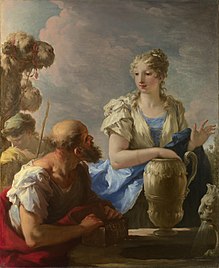Almah

Almah (עַלְמָה ‘almāh, plural: עֲלָמוֹת ‘ălāmōṯ), from a root implying the vigour of puberty,[1] is a Hebrew word for a young woman of childbearing age.[2] Despite its importance to the account of the virgin birth of Jesus in the gospel of Matthew, scholars agree that it has nothing to do with virginity.[2] It occurs nine times in the Hebrew Bible.[3]
Etymology and social context
Almah derives from a root meaning "to be full of vigour, to have reached puberty".[1] In the ancient Near East girls received value as potential wives and bearers of children: "A wife, who came into her husband's household as an outsider, contributed her labor and her fertility ... [h]er task was to build up the bet 'ab by bearing children, particularly sons" (Leeb, 2002).[4] Scholars thus agree that almah refers to a woman of childbearing age without implying virginity.[2]
Bible usage
The word almah occurs nine times in the Hebrew Bible:[3]
- A servant of Abraham tells his master how he met Rebeccah. He prayed to the Lord that if an almah came to the well and he requested a drink of water from her, that should she then provide him with that drink and also water his camels; he would take that as a sign that she was to be the wife of Isaac. Rebecca, a young, unmarried girl, is that almah.
- Miriam, an almah, is entrusted to watch the baby Moses; she takes thoughtful action to reunite the baby with his mother by offering to bring the baby to a Hebrew nurse maid (her mother).
- In 1 Chronicles 15:20 and Psalm 46 heading a psalm is to be played "on alamot". The musical meaning of this phrase has become lost with time: it may mean a feminine manner of singing or playing, such as a girls' choir, or an instrument made in the city of "Alameth".
- In a victory parade in Psalm 68:25, the participants are listed in order of appearance: 1) the singers; 2) the musicians; and 3) the "alamot" playing cymbals or tambourines.
- The Song of Songs 1:3 contains a poetic chant of praise to a man, declaring that all the alamot adore him. In verse 6:8 a girl is favorably compared to 60 Queens (wives of the King), 80 Concubines, and numberless alamot.
- In Proverbs 30:19, a difference between the Hebrew texts and the Greek Septuagint leads to divergent interpretations. The focus of the text is consternation over an adulterous wife. The author compares this adulterous wife's acts to things he claims are hard to understand: a bird flying in air, the movement of a snake over a rock, navigation of a ship through the sea and how a man is with an almah. (The Septuagint reads "and the way of a man in his youth" instead.)
- The verses surrounding Isaiah 7:14 tell how Ahaz, the king of Judah, is told of a sign to be given in demonstration that the prophet's promise of God's protection from his enemies is a true one. The sign is that an almah is pregnant and will give birth to a son who will still be very young when these enemies will be destroyed.[5]
References
- ^ a b Childs 2001, p. 66.
- ^ a b c Sweeney 1996, p. 161.
- ^ a b Byrne 2009, p. 155.
- ^ Leeb 2002, p. unspecified.
- ^ Preuss 2008, p. 461.
Bibliography
- Byrne, Ryan (2009). "Anatomy of a Cargo Cult". In Byrne, Ryan; McNary-Zak, Bernadette (eds.). Resurrecting the Brother of Jesus: The James Ossuary Controversy and the Quest for Religious Relics. University of North Carolina Press. ISBN 9780807895498.
{{cite book}}: Invalid|ref=harv(help) - Childs, Brevard S (2001). Isaiah. Westminster John Knox Press. ISBN 9780664221430.
{{cite book}}: Invalid|ref=harv(help) - Gravett, Sandra L.; Bohmbach, Karla G.; Greifenhagen, F.V.; Polaski, Donald C. (2008). An Introduction to the Hebrew Bible: A Thematic Approach. Westminster John Knox Press. ISBN 9780664230302.
{{cite book}}: Invalid|ref=harv(help) - Leeb, C.S. (2002). "The widow: homeless and post-menopausal". Biblical Theology Bulletin. 32 (4): 160–162. doi:10.1177/014610790203200403. Archived from the original on 2013-01-03.
{{cite journal}}: Invalid|ref=harv(help) - Preuss, Horst Dietrich (1974). "Isaiah". In Botterweck, Gerhard Johannes; Ringgren, Helmer (eds.). Theological Dictionary of the Old Testament. Vol. I. Eerdmans. ISBN 9780802823250.
{{cite book}}: Invalid|ref=harv(help) - Sweeney, Marvin A. (1996). Isaiah 1-39: With an Introduction to Prophetic Literature. William B. Eerdmans Pub. Co. ISBN 9780802841001.
{{cite book}}: Invalid|ref=harv(help)
